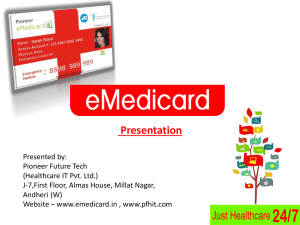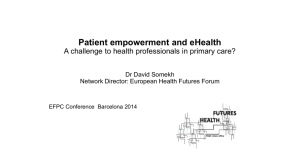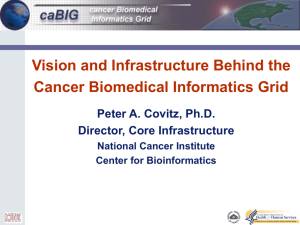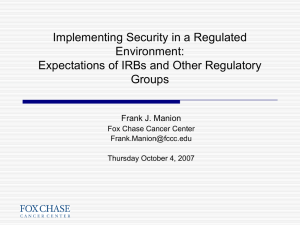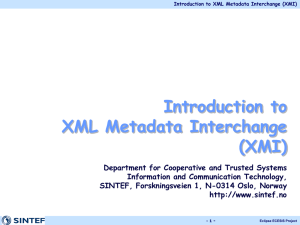International u-Health Initiative
advertisement
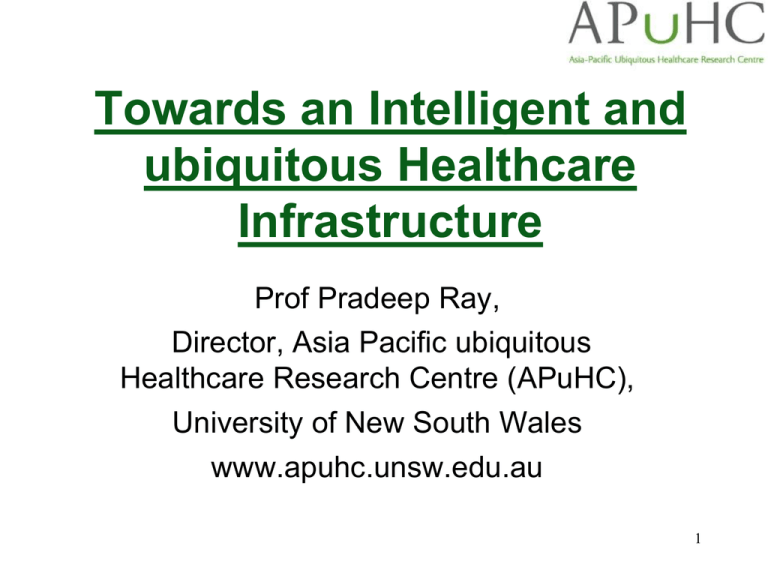
Towards an Intelligent and ubiquitous Healthcare Infrastructure Prof Pradeep Ray, Director, Asia Pacific ubiquitous Healthcare Research Centre (APuHC), University of New South Wales www.apuhc.unsw.edu.au 1 Constituents of e-Health* Administrative and Financial Systems e-Pharmacy Electronic Health Record Telemedicine m-Health e-Health *ITU-Seminar On e-Health2003 2 APuHC Research Programs 1. Projects on e-Research infrastructure – UNSW e-Research Infrastructure for health incl Cancer Biomedical Informatics Grid (CaBIG) and electronic Practice Based Research Network (ePBRN) 2. eHealth Projects on primary care and aged care – New $1million collaborative initiative supported by the Aged Care IT Council incl contributions from industry and universities 3. International projects on the assessment of mHealth – Global mHealth Assessment Initiative ($1.6 million) with contributions from WHO &UGeneva (Swisse), AII (Aust), INSA-Lyon(France), NST (Norway), PNG Health (PNG), CMC (Ind), TRCL & ICDDRB(B’Desh), NUS (Singapore), UBC (Canada), IEEE &NIH (USA), CDC(China), POLIMI (Italy) 3 Benefits of Mobile Communication Technology in Healthcare • Improved quality of care (e.g. better and/or faster diagnosis, improved treatment compliance, access to healthcare professionals, support for carers, etc.) • Reduced healthcare costs (e.g. fewer number of physician appointments, shorter hospital stays, avoidance of unnecessary admissions, etc.) • Reduced chances of medical or administrative errors (e.g. by avoiding duplication of data entry, better coordination in multi-disciplinary settings, etc.) • Increase efficiency (e.g. in administrative processes, billing, etc.) • Improve knowledge base (e.g. epidemiology statistics, research databases, etc) APuHC in Global mHealth • APuHC jointly led (with Tokai Univ-Japan) ITU-D/IEEE Mobile eHealth Initiative for Developing Countries, started in 2004 (consortium of twenty countries) for mHealth in – Emergency Telemedicine – Epidemic Control – Combating Bioterrorism • Mekong Basin Disease Surveillance (MBDS)-funded by the Rockefeller Foundation (2007-2008) in Laos, Cambodia, Vietnam, Thailand and part of China • APuHC led (2006-2009) the WHO Research on the Assessment of eHealth in four countries in Asia Pacific (India, China, Vietnam and Philippines) leading a comprehensive e-Health Readiness Assessment Methodology- now being used for Pandemic Preparedness • APuHC now leading (since 2010) the global study on the assessment of mHealth in collaboration with twelve countries all over the world 5 Completed WHO Study • WHO Research on the Assessment of eHealth for Health Care Delivery (eHCD) from 2006-2009 • Participant countries: India, China, Vietnam and Philippines • eHealth Scenarios Studied: – Demonstration of cost-effectiveness of Electronic Patient Records (EPRs) in Primary Healthcare Centres (PHCs) in a country (Vietnam and Philippines) – Demonstration of training effects and improved quality through teleconsultation in cardiology (China and India) – Evaluation of the usage of e-learning modalities in PHCs (India and Philippines) • Led to APuHC eHealth Readiness Assessment 6 Methodology and Framework (EHRAM) Program 3 Projects • SMS-based Smoking Cessation (Aust/NZ) sponsored by HSAGlobal (NZ), Macquarie Telecom, NST (Norway) and ePBRN (Aust) • Tele-consultations using Mobile Phones with TRCL (Bangladesh) • SMS based TB Treatment with CMC Vellore (India) funded by Australia India Institute Grant2011 • Screening of cognitive disorders of HIV patients in PNG using smart phones- collaborative project involving researchers in Australia, USA and PNG • Smart phone based Depression Treatment sponsored by the St. Vincent’s Hospital and DOHA (Aust) • SMS based Disease Surveillance in PNG (M2M application) • eHealth Preparedness for Pandemics: case Studies in China and Australia sponsored by the ARC Linkage Project with Aust Hospitals and CDC Beijing SMS based mHealth Service Patient Database Contact Details Language Preference TB History Progress reports Message DB Monitoring Program Medication reminders and confirmations Awareness Message distribution program Awareness and motivational messages ITU-T M2M Focus Group work plan(March2012) General points open for consideration for work plan – To develop the work plan in alignment with FG ToRs – To develop vision and high level objectives based on FG ToRs – To consider if a) Use cases for healthcare only b) use cases also for other M2M sectors (from a synergy perspective) c) also some use cases from other (few key) M2M sectors (sourced from external) to be used for the Service Layer work – It is assumed independence from specific network technologies – It would be useful to describe interaction among the WGs (in terms of work process) – Life time of the FG Public M2M Applications National level Access to database Automatically generated reports PUBLIC HEALTH ACTION Provincial level MoH MoH Access to data PUBLIC HEALTH ACTION District level Smart phone with template SMS ACTION SMS ACTIO N Can smart phones enable timely and representative outbreak data? • Implementation of pilot study » Randomise sites, train staff etc • Evaluation of pilot – Qualitative (Focus groups, key informant interviews – Sustainability (functionality, acceptability, ownership) – Quantitative (Pre & post (Districts prior to smart phones vs. post) & Comparative (Districts with smart phones vs. without) • Indicators – Number of outbreaks identified – Number of districts reporting timely data – Number of provincial hospitals reporting timely data – Number of investigations conducted (e.g. measles cases) Screening Neuro-Cognitive Disorders using Smartphones In the next 10 minutes or so, we will ask you to sit in quiet space at a table and place your phone horizontally on the table, right in front of you, exactly as shown in the picture. Do you wear glasses? Please put them on i Welcome! Wecoome ! In the next 4 tasks we will test how well you can concentrate, how fast you can move shapes, how fast you can tap on a shape on the screen, and how well you can remember some shapes. We will then ask you a few questions about how good you think your concentration and memory are. When you OK are ready, Press ‘OK’ to start the test OK APuHC Program 1 Projects • Projects on eResearch infrastructure (Cooperative Management and Interoperability) in Australia and overseas (eg, India) APuHC researchers and collaborators in this program work on the development and management of ontology-based e-Research infrastructure needed for the electronic sharing of research data by researchers in different academic disciplines (e.g., healthcare research). Agents for HealthCare 1 PATIENT PATIENT COMPLAINT COMPLAINT INVESTIGATION INVESTIGATION HISTORY HISTORY EXAMINATION EXAMINATION TESTS TESTS 2 3 4 TREATMENT TREATMENT PLAN PLAN DIAGNOSIS DIAGNOSIS 5 TREATMENT TREATMENT COMPLETION COMPLETION & RESOLUTION & RESOLUTION THE HEALTHCARE CYCLE 8 PATIENT PATIENT 7 6 Sporadic Contact 8 DOCTOR DOCTOR 7 6 Most Healthcare Technology is dedicated to the resolution of a patient’s complaint There is a lack of software that fulfills the patient and doctor’s needs when NOT actively managing a complaint (activities 6-8). The Agent paradigm offers a solution to this issue. Ontology-based and Intelligent Systems Ontology Mapping Research in the context of the Semantic Web eHealth Privacy Management First order logic, model theory Ontology Development Application and business logic modelling SWRL, RuleML Cancer Biomedical Information Grid caBIG® Vision/Goals (adopted in 200 organisations) caBIG® Vision A virtual network of interconnected data, individuals, and organizations whose goal is to redefine how research is conducted, care is provided, and patients/participants interact with the biomedical research enterprise. caBIG® Goals – Adapt or Build tools for collecting, analyzing, integrating, and disseminating information associated with cancer research and care – Connect the cancer research community through a shareable, interoperable electronic infrastructure – Deploy and Extend standard rules and a common language to more easily share information caBIG Application Bundles Compatibility Achieved through caBIG™ Bundles Clinical Trials Compatibility Framework • • • • • • C3PR PSC caAERS caXchange CTODS caGrid Life Sciences Distribution • • • • • • • CTODS caArray caTissue geWorkbench caGWAS NCIA caGrid Data Sharing and Security Framework • caBIG™ Policies • Processes and Best Practices • Model Documents • Trust Fabric caBIG™ Clinical Trials Framework PSC caXchange C3PR CTODS CLINICAL TRIALS COMPATIBILITY FRAMEWORK Data Sharing & Security Framework caGrid Data for Sharing caAERS • caAERS: Cancer Adverse Event Reporting System • caXchange: Cancer Data Exchange System • PSC: Patient Study Calendar • C3PR: Cancer Central Clinical Participant Registry • CTODS: Clinical Trials Object Data System • caGrid: caBIG™ compatible systems architecture caBIG® Data Sharing and Security Framework (DSSF) The Data Sharing and Security Framework includes: • Resources to address the legal and cultural barriers to data sharing: – Tools to evaluate the sensitivity of data – Tools to expedite the execution of data sharing agreements between organizations (guidelines for data sharing plans) – Tools to capture patient consent to share data (model informed consent forms) – Other model documents and white papers to inform institutions on data sharing issues • Technology infrastructure to ensure secure data exchanges: – Tools to implement federated authentication and authorization – Policies to assure that organizations adhere to security standards (Grid Host Agreement) • Five steps in developing a caBIG™ compatible application 1. Creating an Information Model 2. Performing Semantic Integration (Vocabularies) 3. Transforming the Information Model into Metadata (Common Data Elements) 4. Generating Code and Messaging Interfaces (API’s) 5. Generating a caGrid Interface y Create an Information Model in a Modeling Tool Perform Semantic Integration using the Semantic Integration Workbench (SIW) Transform the Information Model into Metadata using the UML Loader Generate Code and Messaging Interfaces using the caCORE SDK Code Generator Informa tion Vocabul aries CDEs APIs Generate a caGrid Interface using “Introduce” y Software Development for caBIG XMI File Create an Information Model in a UML Modeling Tool Using SDK CodeG en? YES N O Perform Semantic Integration using the Semantic Integration Workbench (SIW) YES Verified Annotated UML Model CodeGen Success? Generate Code and Messaging Interfaces using the caCORE SDK Code Generator Input for next version XMI File y Upload application to the Grid using Introduce caGrid Introduce Toolkit Roundtrip UML Model caDSR SANDBOX XMI File UML Loader Load to Sandbox Exported using SDK 3.1 format Run caCORE SDK Code Generation NO caDSR Terminology Services XMI File XMI File Transform the Information Model into Metadata using the UML Loader Approved Annotated XMI NO Load to Load Prod Success? Compatibility Terminology Review Services Yes Review Final caCORE SDK Code Generation Public APIs UML Loader Prod SIW RoundTrip caDSR Production Metadata Retrieval Index Service Global Model Exchange caGrid Service Multi-jurisdiction Perspective • More and more international cooperation on eHealth needed across countries and regions for: – – – – Disaster Management Pandemic response Climate Control Management of healthcare (cost, quality, access) • Barriers include different regulatory, cultural, linguistic and regulatory environments in different countries 22 The Ultimate Vision: Intelligent ubiquitous Infrastructure for Personalised Medicine Practice Community Hospital Research Hospital Research Institution Industry Consumer Knowledge Cloud Comparative Effectiveness Decision Support Quality Data Aggregators PharmacoVigilance Analytics Biomedical Research BioSurveillance
